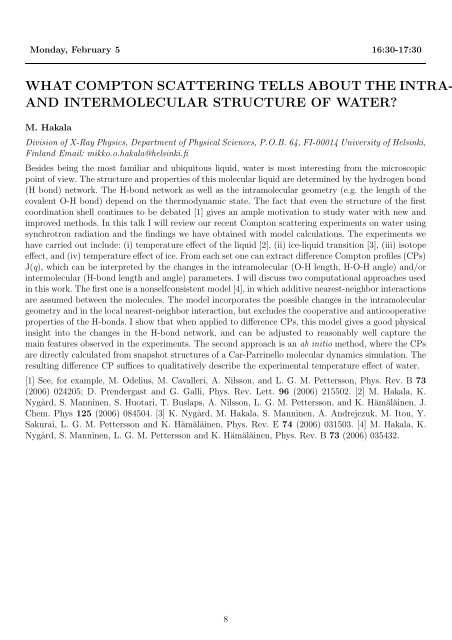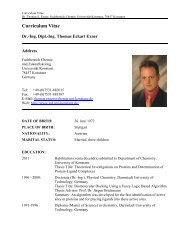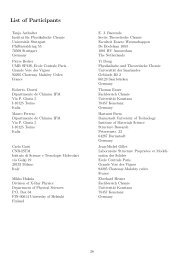The Role of the Lone Pairs in Hydrogen Bonding
The Role of the Lone Pairs in Hydrogen Bonding
The Role of the Lone Pairs in Hydrogen Bonding
Create successful ePaper yourself
Turn your PDF publications into a flip-book with our unique Google optimized e-Paper software.
Monday, February 5 16:30-17:30<br />
WHAT COMPTON SCATTERING TELLS ABOUT THE INTRA-<br />
AND INTERMOLECULAR STRUCTURE OF WATER?<br />
M. Hakala<br />
Division <strong>of</strong> X-Ray Physics, Department <strong>of</strong> Physical Sciences, P.O.B. 64, FI-00014 University <strong>of</strong> Hels<strong>in</strong>ki,<br />
F<strong>in</strong>land Email: mikko.o.hakala@hels<strong>in</strong>ki.fi<br />
Besides be<strong>in</strong>g <strong>the</strong> most familiar and ubiquitous liquid, water is most <strong>in</strong>terest<strong>in</strong>g from <strong>the</strong> microscopic<br />
po<strong>in</strong>t <strong>of</strong> view. <strong>The</strong> structure and properties <strong>of</strong> this molecular liquid are determ<strong>in</strong>ed by <strong>the</strong> hydrogen bond<br />
(H bond) network. <strong>The</strong> H-bond network as well as <strong>the</strong> <strong>in</strong>tramolecular geometry (e.g. <strong>the</strong> length <strong>of</strong> <strong>the</strong><br />
covalent O-H bond) depend on <strong>the</strong> <strong>the</strong>rmodynamic state. <strong>The</strong> fact that even <strong>the</strong> structure <strong>of</strong> <strong>the</strong> first<br />
coord<strong>in</strong>ation shell cont<strong>in</strong>ues to be debated [1] gives an ample motivation to study water with new and<br />
improved methods. In this talk I will review our recent Compton scatter<strong>in</strong>g experiments on water us<strong>in</strong>g<br />
synchrotron radiation and <strong>the</strong> f<strong>in</strong>d<strong>in</strong>gs we have obta<strong>in</strong>ed with model calculations. <strong>The</strong> experiments we<br />
have carried out <strong>in</strong>clude: (i) temperature effect <strong>of</strong> <strong>the</strong> liquid [2], (ii) ice-liquid transition [3], (iii) isotope<br />
effect, and (iv) temperature effect <strong>of</strong> ice. From each set one can extract difference Compton pr<strong>of</strong>iles (CPs)<br />
J(q), which can be <strong>in</strong>terpreted by <strong>the</strong> changes <strong>in</strong> <strong>the</strong> <strong>in</strong>tramolecular (O-H length, H-O-H angle) and/or<br />
<strong>in</strong>termolecular (H-bond length and angle) parameters. I will discuss two computational approaches used<br />
<strong>in</strong> this work. <strong>The</strong> first one is a nonselfconsistent model [4], <strong>in</strong> which additive nearest-neighbor <strong>in</strong>teractions<br />
are assumed between <strong>the</strong> molecules. <strong>The</strong> model <strong>in</strong>corporates <strong>the</strong> possible changes <strong>in</strong> <strong>the</strong> <strong>in</strong>tramolecular<br />
geometry and <strong>in</strong> <strong>the</strong> local nearest-neighbor <strong>in</strong>teraction, but excludes <strong>the</strong> cooperative and anticooperative<br />
properties <strong>of</strong> <strong>the</strong> H-bonds. I show that when applied to difference CPs, this model gives a good physical<br />
<strong>in</strong>sight <strong>in</strong>to <strong>the</strong> changes <strong>in</strong> <strong>the</strong> H-bond network, and can be adjusted to reasonably well capture <strong>the</strong><br />
ma<strong>in</strong> features observed <strong>in</strong> <strong>the</strong> experiments. <strong>The</strong> second approach is an ab <strong>in</strong>itio method, where <strong>the</strong> CPs<br />
are directly calculated from snapshot structures <strong>of</strong> a Car-Parr<strong>in</strong>ello molecular dynamics simulation. <strong>The</strong><br />
result<strong>in</strong>g difference CP suffices to qualitatively describe <strong>the</strong> experimental temperature effect <strong>of</strong> water.<br />
[1] See, for example, M. Odelius, M. Cavalleri, A. Nilsson, and L. G. M. Pettersson, Phys. Rev. B 73<br />
(2006) 024205; D. Prendergast and G. Galli, Phys. Rev. Lett. 96 (2006) 215502. [2] M. Hakala, K.<br />
Nyg˚ard, S. Mann<strong>in</strong>en, S. Huotari, T. Buslaps, A. Nilsson, L. G. M. Pettersson, and K. Hämälä<strong>in</strong>en, J.<br />
Chem. Phys 125 (2006) 084504. [3] K. Nyg˚ard, M. Hakala, S. Mann<strong>in</strong>en, A. Andrejczuk, M. Itou, Y.<br />
Sakurai, L. G. M. Pettersson and K. Hämälä<strong>in</strong>en, Phys. Rev. E 74 (2006) 031503. [4] M. Hakala, K.<br />
Nyg˚ard, S. Mann<strong>in</strong>en, L. G. M. Pettersson and K. Hämälä<strong>in</strong>en, Phys. Rev. B 73 (2006) 035432.<br />
8






